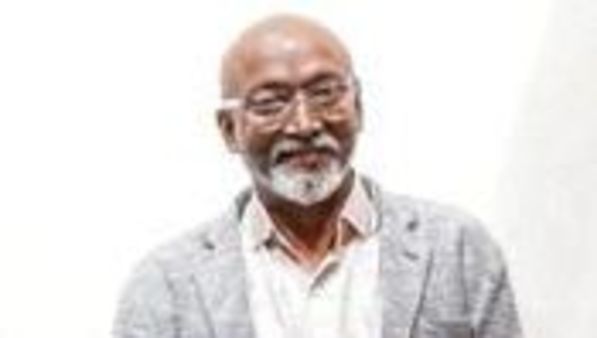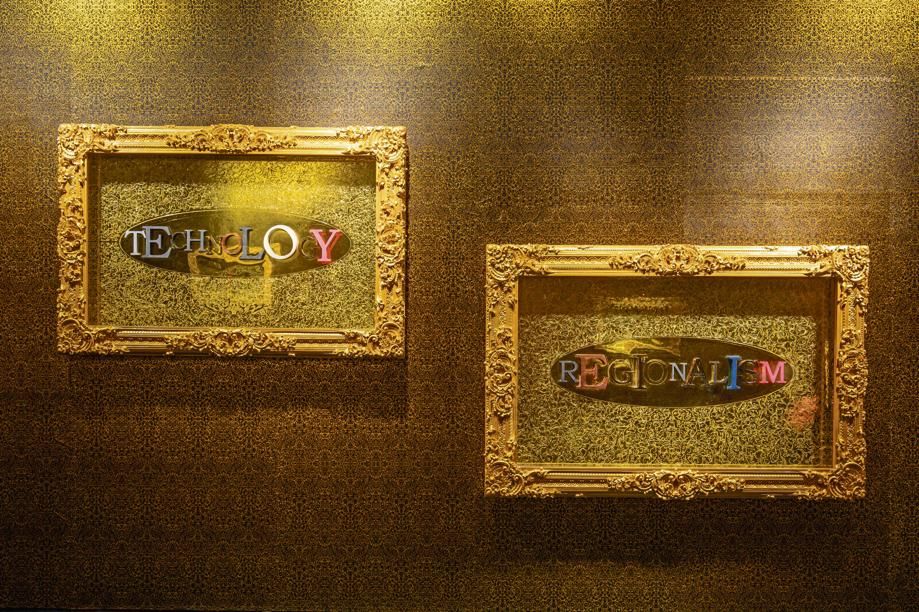At Emami Art, the contemporary gallery at the Kolkata Centre for Creativity, one encounters a series of contradictions. There seems to be a tussle between opulence and austerity, maximalism and minimalism. Walls in plain grey and pale white suddenly give way to brilliant pops of colour. The viewer is confronted with a massive gold frame, hanging on a wall papered with electric blue, with just one word emblazoned across the mirror surface: “Religion”. Right opposite this, graphite frames protrude from the wall. They feature tiny circles, perforated with Braille text. The austere nature of these white-on-white works becomes even more apparent when juxtaposed with the golden frames hanging nearby.

Nine such projects form part of The Mirror Sees Best in the Dark—a self-conceptualized solo by Bose Krishnamachari. “Each project features multiple assemblages and installations. So the total number of works in the show actually comes to around 90,” says the artist, who shuttles between Mumbai and Kochi.
The solo comes after a hiatus of nine years—the artist had last showcased his mobile museum project, LaVa (Laboratory of Visual Arts), in Mumbai between 2006-11. Through the massive archival project—which in 2017 comprised 3,000 books and 1,500 DVDs on contemporary visual art, ranging from graphic design, photography and fashion to design—Bose had hoped to break conventional notions of viewing art and assumptions of an art gallery’s role. “On paper, it may read as though this show (The Mirror…) is a comeback after a long hiatus. However, I do not believe it to be so. I do not consider my practising of art to only be when I wield the brush or scalpel or chisel. My way of life, in itself, involves the application of my artistic sensibilities,” he says.
The exhibition has been two years in the making, with the sociopolitical issues of our times informing and influencing the process of creation. As art critic and cultural theorist Ranjit Hoskote mentions in his catalogue essay: “(Krishnamachari) confronts the increasingly extreme discourses that shape our consciousness.” The mirror acts like a leitmotif in the works. At times it acts as a metaphor for obsession with ideas of nationalism or narcissism. And at other moments, it becomes a means of viewing the fragmented humanity that has come to define our times. The Braille works, particularly, point to the fact that “the sighted can sometimes miss the obvious truth, while the visually challenged can read it with precision”, writes Hoskote.

Bose says the show doesn’t just take off from his immediate experiences, but from those accumulated over a lifetime, whether as a student at the Sir JJ School of Arts, Mumbai (1991) and then at Goldsmiths College, University of London (2000), or as the co-founder of the Kochi Biennale Foundation. “In this project, I have used my philosophy of life. I learnt that extremities can coexist very early on. As a child growing up in Kerala, I came across art forms such as theyyam and Kathakali, which were an amalgamation of colour, music, texture and sound,” he recalls. There was yet another side to Kerala—a more muted, understated one—which came to the fore in local garments such as the mundu or the veshti. As an adult, he came across similar extremes in Mumbai, which he describes as a city of chaos with a tremendous sustaining energy. “But when I come back to my studio, I have an urge to make it as minimalist a space as possible. The point is that this contradiction or ambivalence in life gives rise to a conflict zone. And one can learn a lot from this grey area,” says Bose.
In his new work, he looks at the extremities of obsession, be it with an idea or a person. The highly conceptual project, The Obsession series, has been placed within a scenography of sanctum sanctorum. Carved and gilded frames, layers of ornamental golden mirrors and site-specific words form part of all the assemblages. The artist has specially sketched the wall paper to add a touch of maximalism to the location.
Bose goes on to make a political statement as well, but not in an overt way. “In the past few years, one has felt this insecurity, lack of freedom to voice one’s thoughts. I still feel that we have a very forward-looking culture, but the political situation is putting us on the back foot. The show reflects that in a subtle way,” he adds.
These juxtapositions are evident in the visual language and materiality too. One installation, for instance, features two large stones, nearly 7.5 tonnes in weight, sourced from Kerala. Bose has interpreted the idea of the archaeological museums, which have collections of objects as old as 2,000 years, with ancient scripts written on them. He has chosen 10 words—treating them like the 10 commandments—and inscribed them on to the rocks. “On one, I have created a symbol akin to that of the Ashoka Chakra. The other rock features text in Braille. The perforations are engraved on stone and not embossed. There is this play of the positive and negative,” he says. As one enters the gallery, the same 10 words make an appearance yet again, albeit in a different form. “This is a departure from the maximalist approach outside. The white-on-white paper works and graphite plates form part of the art vocabulary of minimalism,” says Bose. Materials such as steel, brass, copper, granite, graphite and wood have also been used in the show. The mirror sheets, made from Kerala’s famous Aranmula kannadi (handmade metal-alloy mirrors made in the town of Aranmula), have been cut out to resemble free hand drawings. Each work features multiple layers to create a kind of chaos. “What we see in Bose’s recent works is a portrait of what we have done to ourselves today, at the level of the individual, the community, the religious group, the nation-state. The times are dark, and Bose’s mirror is designed to see—and reveal—better in such conditions,” writes Hoskote.
The Mirror Sees Best in the Dark can be viewed at Emami Art, Kolkata, till 10 March.




